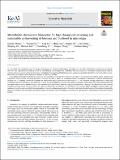| dc.contributor.author | Zheng, Guoxia | |
| dc.contributor.author | Cui, Yutong | |
| dc.contributor.author | Lu, Ling | |
| dc.contributor.author | Guo, Ming | |
| dc.contributor.author | Hu, Xuejun | |
| dc.contributor.author | Wang, Lin | |
| dc.contributor.author | Yu, Shuping | |
| dc.contributor.author | Sun, Shenxia | |
| dc.contributor.author | Li, Yuancheng | |
| dc.contributor.author | Zhang, Xingcai | |
| dc.contributor.author | Wang, Yunhua | |
| dc.date.accessioned | 2023-10-30T16:01:54Z | |
| dc.date.available | 2023-10-30T16:01:54Z | |
| dc.date.issued | 2023-07 | |
| dc.identifier.uri | https://hdl.handle.net/1721.1/152541 | |
| dc.description.abstract | As a renewable and sustainable source for energy, environment, and biomedical applications, microalgae and microalgal biodiesel have attracted great attention. However, their applications are confined due to the cost-efficiency of microalgal mass production. One-step strategy and continuous culturing systems could be solutions. However, current studies for optimization throughout microalgae-based biofuel production pipelines are generally derived from the batch culture process. Better tools are needed to study algal growth kinetics in continuous systems. A microfluidic chemostatic bioreactor was presented here, providing low-bioadhesive cultivations for algae in a cooperative environment of gas, nutrition, and temperature (GNT) involved with high throughput. The chip was used to mimic the continuous culture environment of bioreactors. It allowed simultaneously studying of 8 × 8 different chemostatic conditions on algal growth and oil production in parallel on a 7 × 7 cm2 footprint. On-chip experiments of batch and continuous cultures of Chlorella. sp. were performed to study growth and lipid accumulation under different nitrogen concentrations. The results demonstrated that microalgal cultures can be regulated to grow and accumulate lipids concurrently, thus enhancing lipid productivity in one step. The developed on-chip culturing condition screening, which was more suitable for continuous bioreactor, was achieved at a half shorter time, 64-times higher throughput, and less reagent consumption. It could be used to establish chemostat cultures in continuous bioreactors which can dramatically accelerate the development of renewable and sustainable algal for CO2 fixation and biosynthesis and related systems for advanced sustainable energy, food, pharmacy, and agriculture with enormous social and ecological benefits. | en_US |
| dc.language.iso | en | |
| dc.publisher | Elsevier BV | en_US |
| dc.relation.isversionof | 10.1016/j.bioactmat.2022.07.012 | en_US |
| dc.rights | Creative Commons Attribution Noncommercial No Derivatives | |
| dc.rights.uri | http://creativecommons.org/licenses/by-nc-nd/4.0/ | en_US |
| dc.source | Elsevier BV | en_US |
| dc.title | Microfluidic chemostatic bioreactor for high-throughput screening and sustainable co-harvesting of biomass and biodiesel in microalgae | en_US |
| dc.type | Article | en_US |
| dc.identifier.citation | Zheng, Guoxia, Cui, Yutong, Lu, Ling, Guo, Ming, Hu, Xuejun et al. 2023. "Microfluidic chemostatic bioreactor for high-throughput screening and sustainable co-harvesting of biomass and biodiesel in microalgae." Bioactive Materials, 25. | |
| dc.contributor.department | Massachusetts Institute of Technology. School of Engineering | |
| dc.relation.journal | Bioactive Materials | en_US |
| dc.eprint.version | Final published version | en_US |
| dc.type.uri | http://purl.org/eprint/type/JournalArticle | en_US |
| eprint.status | http://purl.org/eprint/status/PeerReviewed | en_US |
| dc.date.updated | 2023-10-30T15:55:04Z | |
| dspace.orderedauthors | Zheng, G; Cui, Y; Lu, L; Guo, M; Hu, X; Wang, L; Yu, S; Sun, S; Li, Y; Zhang, X; Wang, Y | en_US |
| dspace.date.submission | 2023-10-30T15:55:06Z | |
| mit.journal.volume | 25 | en_US |
| mit.license | PUBLISHER_CC | |
| mit.metadata.status | Authority Work and Publication Information Needed | en_US |
